
09-12-2025 12:06
 Andgelo Mombert
Andgelo Mombert
Bonjour,Je recherche l'article concernant Hypobryo

07-12-2025 16:07
Arnold BüschlenHallo, ich habe in einer Moos-Aufsammlung (epiphy

08-12-2025 21:04
Mark Stevens"Hello everyone,I'm relatively new to microscopy (

08-12-2025 18:59
 Lothar Krieglsteiner
Lothar Krieglsteiner
.. found by a seminar-participant, I do not know t

08-12-2025 17:37
 Lothar Krieglsteiner
Lothar Krieglsteiner
20.6.25, on branch of Abies infected and thickened

16-03-2014 22:00
Hello,I found this species a few months ago but ha

08-12-2025 13:39
Thomas Læssøehttps://svampe.databasen.org/observations/10572899
 Hello,
Hello,I'd like to ask for your help with this small Scutellinia. It was growing on a sandy soil (might be calcareous) among fallen leaves. Locality is warm in general, but this place is on a deeply cut forest path, maybe with a bit colder microclimate.
Marginal hairs short, 131-236 (285) × 16,9-18,3 (20,3) um, simple to bifurcate base, 1-4(-5)-septate.
Spores subglobose, (17,4) 18,1–19,8 (20,4) × (16,1) 16,9–18,3 (18,9) um (live in water), Q = 1-1,1 (1,2), Me = 19 × 17,4 um.
Ornamentation: dense small warts about 0,5 um diam., usually in confluent clusters 0,7-1,7 (2,9) um wide, height 0,4-0,7 um.
The closest species I found in Schumacher and Cahiers FBMDS were S. hyperborea, which has isodiametric non-confluent warts and longer hairs, and S. patagonica, which has much longer hairs. S. subhirtella has more ellipsoid spores.
I'm not sure either, how to interpret the ornamentation, which one is the final one (small standalone warts, or clustered warts).
Thank you in advance.
Je pense qu'il s'agit de Scutellinia patagonica (Rehm) Gamundi Je vous remets en dossiers attachés mes dessins de S patagonica et de S. hyperborea, pour comparaison (j'espèce que les images vont passer).
Cordialement
René

when comparing my find with your drawings (and, e.g. description given by B.Jeannerot in Ascomycete.org 5(5)), the spore shape, size and ornamentation speak for S. patagonica. However, two characters differ quite a lot: Hairs should be cca three times longer in S. patagonica and so far, I didn't find description of any collection with such a short hairs. From the macrophoto it is clear, that they barely reach beyond the apothecial margin (this excludes possibility, that I made preparation from a piece of margin that was inbetween longer hairs). Or is it still within species variability?
Other thing is its ecology: S. patagonica is referred to the boreo-polar group by Schumacher, collections described by Jeannerot (op.cit.) or Van Vooren (Cahiers de FMBDS) support this placement. This collection is from ca 250-300 m asl. in warm lowland, nordeastern slope, less than 1 km from one of the northernmost localities of a mediterranean orchid Himantoglossum adriaticum.
Unfortunately I didn't try if the perispore loosens or not, I'll check this when I'm at home at saturday. Yao & Spooner describe this feature for british finds of S. patagonica, but not for the neotype.
Other possibility would be S. peloponnesiaca J.Mor., with loosening perispore and ornamentation similar to S. patagonica but shorter hairs. There is another collection from Slovakia, determined as S. peloponnesiaca by S.Glejdura, with short hairs, 4spored asci and from cca 400-500 m asl., but I didn't see any microcharacters illustrated. My collection has constantly 8spored asci. But Schumacher wrote that Moravec's species is just a result of abnormal development with "eaten" hairs and synonymized it under patagonica.
... I guess I have to go there again and try to find more apothecia for a better knowledge of this collection.
update: S. Glejdura identified this collection as S. peloponnesiaca. He published 7 collections from 3 slovak localities, all have consistently short hairs, smaller spores than patagonica, and frequently less than 8 mature spores. There is also a scottish collection (see Yao & Spooner 1996) that would be useful to compare, with smaller spores than patagonica and loosening perispore, alas the hair size is not given.

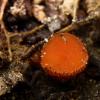
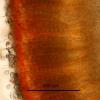

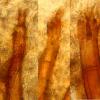
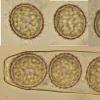
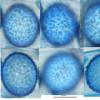
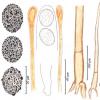
 Scutellinia-hyperboera-M-1-0001.jpg
Scutellinia-hyperboera-M-1-0001.jpg